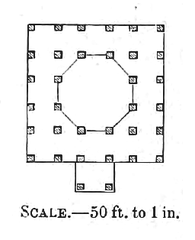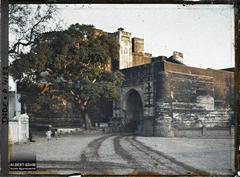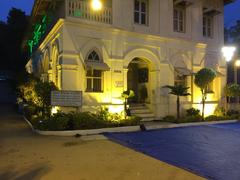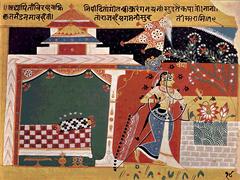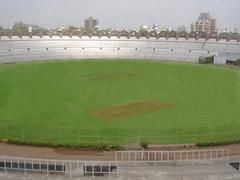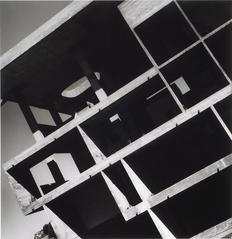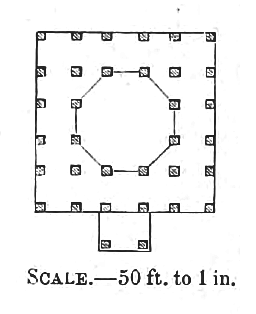
Visiting Mir Abu Turab’s Tomb: Tickets, Hours, and Highlights
Date: 01/08/2024
Introduction
Mir Abu Turab’s Tomb, also known as Qadam-e-Rasul ki Dargah, is a historical and religious landmark situated in Behrampura, Ahmedabad, India. This medieval tomb stands as a testament to the architectural and cultural heritage of the Gujarat Sultanate period, blending Islamic and local Gujarati styles. The tomb is dedicated to Mir Abu Turab, a significant figure during the Mughal rule under Emperor Akbar. Born in the 16th century, Mir Abu Turab served as the chief of the army and was appointed the chief of the Mecca caravan in 1579. His most notable contribution was bringing back a large stone from Mecca in 1582, which bore the footprint of the Prophet Mohammed (Wikipedia). This stone relic holds immense religious significance and is a major draw for pilgrims and visitors alike. The tomb’s architectural beauty, coupled with its rich historical and cultural significance, makes it a must-visit site in Ahmedabad. This guide will provide you with comprehensive information on the history, architectural marvels, visiting hours, ticket information, and practical tips to help you make the most of your visit to Mir Abu Turab’s Tomb.
Table of Contents
- Introduction
- History and Significance
- Visitor Information
- Travel Tips
- Nearby Attractions
- FAQ
- Conclusion
History and Significance
Historical Background
Mir Abu Turab’s Tomb is named after Mir Abu Turab, a notable figure during the Mughal rule under Emperor Akbar. Born in the 16th century, he served as the chief of the army and was appointed the chief of the Mecca caravan in 1579. His most notable contribution was bringing back a large stone from Mecca in 1582, which bore the footprint of the Prophet Mohammed. This stone is believed to be the same one that Syed Jalal-i-Bukhari brought to Delhi during the reign of Sultan Firuz Shah Tughlaq (Wikipedia).
The Stone Relic
The stone relic brought by Mir Abu Turab holds immense religious significance. Initially taken to Akbar at Fatehpur Sikri, the stone was received with great respect, although Akbar himself considered it a pious fraud. Despite this, Mir Abu Turab was allowed to keep the stone in his house. When Itimad was appointed Governor of Gujarat in 1583, Mir Abu Turab followed him as Amin of the Suba. He was eventually buried in Ahmedabad in 1597. The stone was later moved to Ahmedabad, where a building was constructed over it, attracting large numbers of pilgrims (Islamic Heritage).
Architectural Significance
Mir Abu Turab’s Tomb is an exemplary piece of medieval architecture. The tomb is built on a 12.5 square meter (41 feet) square platform and features a double colonnade of pillars. The inner colonnade was originally enclosed by stone trellis work. The tomb’s design is simple yet graceful, showcasing local architectural styles at their best. The flat lintels have been replaced by arches, and the absence of rich minaret bases ensures a uniform and pleasing appearance. Each face of the tomb features three large and two small arches, indicating the presence of an octagonal dome supported by twelve pillars (Wikipedia).
Restoration Efforts
The tomb suffered significant damage during the 2001 Gujarat earthquake. However, it was restored in 2002 by the Archaeological Survey of India. The restoration efforts aimed to preserve the tomb’s historical and architectural integrity while making it safe for visitors (Islamic Heritage).
Cultural and Religious Importance
The tomb of Mir Abu Turab is not just a historical monument but also a site of religious significance. The stone relic with the footprint of the Prophet Mohammed makes it a revered site for pilgrims. Over the centuries, the tomb has attracted numerous visitors who come to pay their respects and seek blessings. The site also serves as a reminder of the rich cultural and religious history of the region.
Visitor Information
Visiting Hours
Mir Abu Turab’s Tomb is open to visitors from 9:00 AM to 6:00 PM daily. It is advisable to check for any changes in timings during public holidays or special religious events.
Ticket Prices
Entry to Mir Abu Turab’s Tomb is free for all visitors. However, donations are welcome to support the upkeep and maintenance of the site.
Accessibility
The tomb is accessible to visitors of all ages. However, the uneven terrain and steps may pose challenges for those with mobility issues. It is recommended to bring any necessary assistance if required.
Travel Tips
Best Time to Visit
The ideal time to visit Ahmedabad is during the winter months (November to February) when the weather is pleasant.
Dress Code
As a religious site, modest clothing is recommended. Visitors should cover their heads as a sign of respect.
Guided Tours
Consider hiring a local guide to gain deeper insights into the historical and cultural significance of the tomb.
Photography
Photography is allowed, but it is advisable to seek permission before taking pictures inside the tomb.
Nearby Attractions
Sarkhej Roza
A beautiful complex of tombs and mosques located about 10 km from Mir Abu Turab’s Tomb.
Jama Masjid
One of the most famous mosques in Ahmedabad, known for its stunning architecture.
Sabarmati Ashram
The residence of Mahatma Gandhi, offering a glimpse into the history of the Indian independence movement.
FAQ
Q: What is the significance of the stone relic at Mir Abu Turab’s Tomb? A: The stone relic is believed to bear the footprint of the Prophet Mohammed, making it a site of immense religious significance.
Q: Are there any restrictions on visiting the tomb? A: There are no major restrictions, but visitors are advised to dress modestly and respect the religious nature of the site.
Q: How can I get to Mir Abu Turab’s Tomb? A: The tomb is located in Behrampura, Ahmedabad. It is easily accessible by local transport, including buses and rickshaws.
Conclusion
Mir Abu Turab’s Tomb stands as a testament to the rich history and cultural heritage of Ahmedabad. Its architectural beauty, coupled with its religious significance, makes it a unique and important site. The tomb not only commemorates the life and contributions of Mir Abu Turab but also serves as a symbol of the region’s historical and cultural legacy. Visitors to the tomb can expect to be transported back in time, experiencing the grandeur of Mughal architecture and the deep-rooted religious traditions that continue to thrive in this historic city.
References
- Wikipedia. (n.d.). Mir Abu Turab’s Tomb. Retrieved January 8, 2024, from Wikipedia
- Islamic Heritage. (n.d.). Mir Abu Turab ka Roza. Retrieved January 8, 2024, from Islamic Heritage
- Wikimedia Commons. (n.d.). Mir Abu Turab’s Tomb. Retrieved January 8, 2024, from Wikimedia Commons
- Gujarat Tourism. (n.d.). Sidi Saiyyed Mosque. Retrieved January 8, 2024, from Gujarat Tourism
- Sabarmati Ashram. (n.d.). Sabarmati Ashram. Retrieved January 8, 2024, from Sabarmati Ashram
- Gujarat Tourism. (n.d.). Jama Masjid. Retrieved January 8, 2024, from Gujarat Tourism
